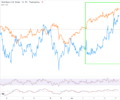
Australian Dollar -4.63%
At just short of 5% down on the year against USD, the Australian Dollar takes home the crown for worst performing currency in the G10 space.
Over the course of the year, the Australian Dollar was hard hit by the breakdown in US-Sino trade talks which put a great deal of pressure on the Australian economy. With China being the country’s largest trading partner, AUD has long been used as a proxy currency for trading the Chinese economy. The fresh outbreak of tariffs earlier in the year as trade talks collapsed saw the outlook for the Chinese economy turning lower as key indicators started to head lower. The economic uncertainty caused by the trade war not only weighed on the outlook for trade between the US and China but also on the outlook for commodity prices. As the prices of some of Australia’s main tradeables turned lower, alongside a drop in demand , the AUD was heavily lower.
In response to the deteriorating economic situation both at home and globally, the RBA was called into action and was forced to cut rates three times over the year taken rates down to record lows of 0.75%. Throughout the year, the RBA continued to cite low household income, high household debt and subdued wage growth as the main internal economic threats. While the labour market was said to be strong, it was not feeding into upward price pressures and as the housing market started to come off over the year, the Australian Dollar headed lower still.
Into the final part of the year, with the US and China finally confirming a trade deal, the AUD has been able to carve out a bottom, which is holding for now, though whether this will prove simply to be a minor correction in the long term bearish trend remains to be seen.
New Zealand Dollar -4.09%
Along with its Antipodean partner, the New Zealand dollar was also hard hit over the year, falling nearly as much as the Australian Dollar. For most of the same reasons that AUD was lower over the year, the New Zealand dollar too suffered as a result of the re-emergence of the US-Sino trade war which rocked world trade and crippled world growth over the middle of the year.
The impact on the domestic uncertainty was met by swift action from the RBNZ. In August, against a backdrop of easing expectations, the RBNZ took the market by surprise by cutting rates by a 50 basis points, double the expected 25 basis point rate cut the market was looking for.
At its latest meeting, the RBNZ kept dovish expectations elevated noting that inflation expectations had fallen further and said that, although at present, economic conditions do warrant a change in policy, the RBNZ remains ready to act further if economic conditions should warrant additional easing. All policy members agreed that accommodative monetary policy remains necessary to support the bank’s goals. While the prospect of a recovery in world trade as a result of the US-Sino trade deal is encouraging, in the near term, the domestic economy is likely to continue to struggle.
Disclaimer: The material provided is for information purposes only and should not be considered as investment advice. The views, information, or opinions expressed in the text belong solely to the author, and not to the author’s employer, organization, committee or other group or individual or company.



 SP500
SP500 FTSE
FTSE FCE
FCE Nasdaq100
Nasdaq100 Russell2000
Russell2000 Index Nikkei225
Index Nikkei225 DOW 30 (DJI)
DOW 30 (DJI) RTS futures
RTS futures RTSI
RTSI DAX30
DAX30 eBay Inc.
eBay Inc. Google Inc.
Google Inc. IBM Corp.
IBM Corp. Microsoft
Microsoft  Apple
Apple Yandex
Yandex Toyota
Toyota Volkswagen
Volkswagen Facebook
Facebook Tesla
Tesla Twitter
Twitter Hasbro
Hasbro Bitcoin
Bitcoin Litecoin
Litecoin BitcoinCash
BitcoinCash Dash
Dash Ripple
Ripple Ethereum
Ethereum EmerCoin
EmerCoin NameCoin
NameCoin PeerCoin
PeerCoin Monero
Monero ETC/USD
ETC/USD Silver
Silver Platinum
Platinum Palladium
Palladium Copper
Copper Gold
Gold